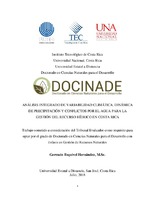Análisis integrado de variabilidad climática, dinámica de precipitación y conflictos por el agua para la gestión del recurso hídrico en Costa Rica
Resumen
Water resources management in the tropics is challenged by climate variability and unregulated land use change and their impacts on the complex interactions between vegetation, soil, and atmosphere. Costa Rica, for example, is a nation with a vast wealth of water resources. The country, however, has recently faced water conflicts due to social, economic, legal, and political impediments in response to limited water availability during El Niño events and inefficient use of its water resources. In addition, tropical fragile biomes, such as the Páramo, have been understudied ecosystems for which it is crucial to identify moisture transport pathways influencing rainfall generation processes.
This thesis consists of three parts. The first part focuses on the analysis of hydro-climatic and ecohydrological conditions across six major biomes in Costa Rica. Using the Budyko and the Tomer-Schilling frameworks, reanalysis data points located in the Caribbean and Pacific domains were classified according to their ecohydrological resistance and resilience between 1989 and 2005. Observed data were used to evaluate the reanalysis products. Resistance was defined as the standard deviation in the water excess (Q/P or runoff vs. precipitation), and resilience was defined as the standard deviation of the energy (AET/ PET or actual evapotranspiration vs. potential evapotranspiration) of the water excess. A strong orographic separation was obtained between the water-limited Pacific slope and the energy-limited Caribbean slope. The Caribbean slope is characterized by low resistance and high resilience to changes in the hydro-climatic conditions, with small relative changes in water excess, whereas the Northern Pacific slope has high resistance and low resilience and shows strong changes in water excess. Some areas of the Northern Pacific region covered by lower and pre-montane forests have recently suffered significant increments in the dryness index (PET/P).
The second part presents a spatial distribution and temporal analysis of water conflicts in Costa Rica from 2005 to 2015. In total, 719 water conflicts were analyzed of which 54% were among private individuals and government. The largest urban areas and the Grande de Tárcoles basin were identified as the main ‘hot spot’ for the conflicts. Water conflicts were mainly caused by spills of wastewater, water pollution, water shortage, infrastructure damage, and flooding, and can be predicted using a multiple linear model
x
including the municipal population and the number of hydro-meteorological events (r2=0.77). The identified hydro-meteorological events also coevolved significantly with the changes in precipitation regimes (r=0.67, p=0.021). The findings suggest that there is a need to recognize that water infrastructure longevity across the country concatenates and amplifies water conflicts, mainly in the most populated area located in the Central Valley.
Finally, the third part presents a stable isotope analysis of precipitation and moisture sources using rainfall samples collected on a daily to weekly basis between January 2015 and May 2016 at two Páramo sites: Chirripó (Costa Rica; 3,400 m a.s.l.) and Cajas (southern Ecuador; 3,900 m a.s.l.). Isotopic composition (i.e., δ18O and deuterium excess) was used to identify how rainfall generation influences the seasonal variations at each study site. Air mass back trajectory analysis was used to identify preferential moisture transport pathways. Our results demonstrated the strong influence of the northeast trade winds from the Caribbean Sea at Chirripó and the preferential influence of the Amazon Forest at Cajas. Mean δ18O and deuterium excess altitudinal relationships for local precipitation are consistent with increased condensation rates of atmospheric vapor with elevation. Finally, the hydrological conditions of the glacial lakes located in the highlands of Chirripó, Costa Rica, were assessed using a unique data set of water stable isotopes collected between September 2015 and July 2017. Stable isotope records (δ18O, deuterium excess and line-conditioned excess) of local precipitation, streams, and glacial lakes were compared and used to estimate evaporative losses of lakes using the linear resistance model and the experimental-estimated local evaporation line (LEL) of Chirripó. The isotope signals revealed non-seasonal evaporative conditions for the glacial lakes and evaporation to inflow (E/I) ratios below 10%.
Overall, national and regional strategies are needed to effectively optimize water use efficiency and water storage and to include a climate vulnerability component in future water management plans. These truly integrated water resources management plans should include, for example, water conflicts as indicators of hydro-climatic changing conditions and water supply and sanitation infrastructure status, and could incorporate recently-developed techniques based on the analysis of stable isotopes in precipitation and surface water as indicators of climate variability.
Descripción
Tesis (Doctorado en Ciencias Naturales para el Desarrollo con énfasis en Gestión de Recursos Naturales). Instituto Tecnológico de Costa Rica. Universidad Nacional Costa Rica. Universidad Estatal a Distancia, Doctorado en Ciencias Naturales para el Desarrollo, 2018.


